3d. Taxus
brevifolia var. reptaneta Spjut, J. Bot. Res. Inst. Texas 1 (1): 219.
2007— Type: U.S.A., California, near
corner of Humboldt, Siskiyou and Trinity Counties, 17 mi S of the town of the
Forks of the Salmon on McNeal Creek Road, Knownothing Creek, ca. 1300 m, shrub
with long scandent stems ascending to 5 m or more, stems layering, R. Spjut
& T. Spjut 11835, with seed—holotype US (isotypes: BM BRIT E GH HSC K).
Note: A combination attributed to Silba, Taxus brevifolia subsp. reptaneta with reference
to "J. Int. Conifer Preserv. Soc. 17(1): 22. 2010" (n.v.) is not consistent with
the taxonomic history of the genus as noted above under var. polychaeta.
Diagnostic features: Shrubs with ascending
stems near base, or ascending from a prostrate trunk; vegetative reproduction
often by layering, forming clonal thickets or genets with many ramets; branches
usually
spreading in one direction, ascending, horizontal or descending, usually with
a slightly drooping leader; ovuliferous shoots with a relatively short
primary shoot as in var. brevifolia, with one terminal ovule. or with two
subterminal ovules observed in approximately 25% of the female genets (based on limited surveys in 2010). Thicket yew. NW U.S.A. Scattered or forming
dense thickets on steep sunny slopes of avalanche shoots, along streams, or in
dense shade of bottomland ravines, 1000–2000 m; Rocky Mountains—Idaho, Montana,
British Columbia; E Cascades—Oregon and Washington, Klamath Mountains—Oregon and
California; Coast Ranges—Oregon. The layering habit of var. reptaneta varies. The variety
at the type locality and in NW Montana,
which occurs in open riparian habitats, has thick trunks—more than 50 cm in diam.—that ascend to 5 m or more in length. These bear numerous divaricate
to ascending
branches sometmes longer than that of the main trunk. New trunks develop from layering branches within less than 5
m. Collectively, they form impenetrable yew thickets—as I have observed on
sun-exposed avalanche shoots in the Kootenai National Forest of NW Montana, and
on steep slopes bordering streams in the Klamath Mountains of California (type
locality); hence, the epithet, reptaneta. Another form, which occurs in
understory of old-growth bottomland (valley) forests along the E slopes of the Cascades,
has more scattered genets, and their trunks sometimes twist and wrap
around the base of grand fir and other trees as if ecologically dependent upon
them. Another form of a much lower stature hardly differs from that of T.
canadensis, except for its leaf anatomy; it is common in the Rocky
Mountains.
|
 
  
California: Klamath National Forest,
Marble Mountain Wilderness,
Lake of the Island, 5,650–6,000 ft. Arrows in upper left photo
point to yew thickets on north to northeast exposures, occurring on
almost vertical rock faces and steep talus
slopes, generally of diorite; Spjut 16013, July 2006.
Upper right photo shows closer view of yew thicket. Lower left
photo shows tangled growth of branches, which appear difficult to walk
through. Lower photos show male cones found on all plants
examined in one thicket, as would be expected from plants that layer. Note the
trailing stems along ground in lower left photo. Occurring with
red fir, mountain hemlock, white fir, silver fir, western white pine,
incense cedar, and subalpine fir (very rare). Douglas fir occurring just
below the lake along the trail at 5,400 ft. An orange color appearing
on older leaves of many plants is an apparent disease that I have not
generally seen on yew. |
 
 
California: Marble Mountain Wilderness,
Lake-of-the- Island, small thicket along north shore, 5650 ft.
Here the ground is level, but the plants still show the ascending
stems as if growing on steep slopes. Note the bare stem on one
side, and branches spreading to the other side—all towards the lake. Plants in this thicket were entirely
female in contrast to male thickets seen elsewhere around the lake.
Spjut 16015, July 2006.
|
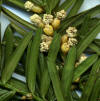 
California: Marble Mountain Wilderness,
Lake of the Island, small thicket along east shore, 5800 ft. Spjut
16014, July 2006.
|
|
 
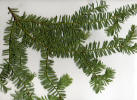 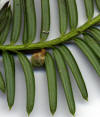
California: Marble Mountain Wilderness,
North Fork of the Salmon River just below junction with Lake of
the Island Trail, 4000 ft. Plants forming thickets but appearing intermediate
in characters of phyllotaxy and habit to var. brevifolia.
Note branches spreading to one side of the main bole. These plants have less crowded leaves in a more definite 2-ranked
arrangement, and the basal branches were not as trailing.
This form is similar to plants seen in understory forests in the
eastern Cascades of Oregon and Washington; Spjut 16016, July
2006 |

Idaho:
. Shoshone Co.: Hobo Cedar Grove Botanical Area,
St Joe NF. Taxus brevifolia
var. reptaneta, a predominant understory shrub in an old growth
forest of largely western red cedar. Photo shows genet with many ramets,
each ramet with ascending stems and branching to
one side,
forming dense thickets; male genets more common than female genets,
representing perhaps 2/3 or more of all genets in population; one
female found with biovulate shoot. Nine samples from different
genets: Male-A,B,D,F,G; female-C,E,H (biovulate) and I. ,
SPJ-16734, 18 July 2010. |
 
California. Siskiyou Co.: Type locality, Knownothing Creek, 17 mi S of the
Forks-of-the-Salmon town. Left photo shows yew thicket.
Aug. 1991.

California. Siskiyou Co.
Male cone, a strobilus and bud-scale-dwarf-shoot and leaf complex at
the end of a primary (fertile) shoot of Taxus brevifolia
var. reptaneta from type locality (Spjut 16717). Photo
taken July 2010. |
|
  
  
Washington—Cascades: Washington
National Forest, 18 mi S of Leavenworth, Icicle Creek, Black Pine Horse Camp,
scattered or forming open thickets locally on flats or gentle slopes in understory of
old growth coniferous forest with Engelmann spruce, Douglas fir, incense cedar, grand fir, sugar pine and ponderosa pine, 47º36 N, 120º56.70W,
3050 ft,
Spjut 12101
(5 Aug 1991),
12302
(15 Aug 1992).
At this site, thicket yew seemed to show a definite close
association with other conifers by growing around their base as
evident in the above photos. Lower right photo shows yellowish seed
attached to branch. Lichen growth on yew branches indicate
that yew plants are not young. In July 2010, the plants
studied earlier apparentlyh were washed out from river flooding; the other conifers were
still there but not the yew. Genets were still thriving downstream but not growing closely around
the base of conifers as shown here.
  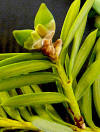
Three photos of Taxus brevifolia var. reptaneta from
Icicle Creek taken July 2010 (Spjut 16723). Left (or top):
habit of genet (in part) with clonal individuals (ramets), the main
stem of each ramet ascending and bearing long
divaricate to descending branches off to one one side of the stem.
Center: two fertile branches, one with a bi-ovulate cone, another with
two ovules arising in the axils of successive leaves. Right (or
bottom) Two ovules at the end of a short
primary (fertile) shoot, and possibly another fertile shoot
aborting development, or could develop into a vegetative shoot.
|
  
Canada—British Columbia: Between Rocky Mountain
National Park and Glacier National Park, 2.5 mi W of Golden, S off Hwy
1, S of Big Lake Resort, elev. ~1000 m. On steep rocky slopes of
narrow ravine, occurring with Douglas fir, western red cedar, maple
and hazelnut, Spjut 12090. 4 Aug 1991. Stems appear
to develop a
basal burl, but no plants were dug up to confirm this observation.

California.
Klamath Natl. Forest: West side of Etna Summit
along
Etna-Sawyer's Bar Road at jct of Taylor Creek and Russian Creek;
41º22'08.94, 23º01'34.11", 3550 ft. Steep north-facing ravine in
Douglas fir forest.
Shrub with several or more basal stems arising from an old large
prostrate stem; stems sharply ascend near base, 2–4 m high;
branching not spiral but in one plane with many branches spreading
in the same direction from the main stem; foliage dark green.
Population of few genets, each with many individuals (ramets). Note
smooth bark and gray color, similar to a young Abies.
SPJ-16770, female genet with developing seeds.
|
 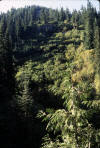
 
 

NW Montana. Lincoln Co., near northern
panhandle of Idaho, Kootenai National Forest, Libby Mt., Snowshoe Mine
Road, T28N R31W Sec. 495, Top photos— provided by David Deevy—shows thicket of yew before collectors debarked stems.
Right photo shows a good view of the habit of the plant after
collectors removed branches and bark from plants. 17 Aug 1992. |
|
 
 
Oregon: E Cascades, E of Portland, Spjut
12301, 15 Aug. 1992. Note branches spreading to one side
|
 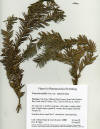 
Montana: Flat Head NF, Swan Lake Dist. Big
Head, Bay Creek road (FS Road 129), T25N R 18W Sec 6; Spjut &
Broster 12308. 18 Aug 1992. Showing low creeping habit much
like T. canadensis, also in the vicinity one large tree of
typical T. brevifolia.
|

 
Idaho. North-central, Clearwater NF, Road to Weippe off FR 100 46º23.327,
115º50.676W,
3172 ft, in western red cedar forest,
Spjut 16833,
25 July 2011. Four ramets shown, one growing at base of Douglas fir;
branches of ramet spreading to one side; pollen cones in cluster
in bud
and matured (with expanded microsporophylls) |
Thicket yew was first thought to be a
distinct species by the darker green foliage with leaves overlapping more
closely and irregularly compared to the typical tree form. This was
based on plants in the Klamath Region of California. It was even
possible to recognize herbarium specimens that had these features, but
primarily in Californian
In studies with assistance from the USDA
Forest Service in the Pacific Northwest Region, the author was directed to
many other sites during Aug 1992 where "shrub yew" was known.
At least four distinct growth forms were recognized in the Klamath Region,
Eastern Cascades, and Rocky Mountains. But these forms could only be
distinguished in the field, not from herbarium material alone.
Nevertheless, each seemed worthy of taxonomic status. Samples from
each of these and also of the typical tree variety (var. brevifolia)
were obtained for taxoid analysis by Professor C.-j Chang. The NW
Montana collection with David Deevy and samples from the type locality
near the Forks-of-the-Salmon in California showed remarkably similar
taxoid content, and were clearly distinct from samples of var.
brevifolia (Spjut et al. 1993). Dr. Chang felt that this was
sufficient evidence for recognizing it as a distinct species; however,
one cannot simply ignore the other shrub samples; they too had to be dealt
with before any new species could be described. Fifteen years later, var. reptaneta still appears to be a
distinct species. The problem remains, however, even with support
from molecular data, that one should be able distinguish a species
in herbarium specimens using morphological characters, and there is also
the question of whether all shrub forms belong to a distinct species with
many varieties or should be simply treated as a single variety as I have
done here. Nonetheless, the various shrub forms all show the
diagnostic features of ascending stems and branches spreading more to one
side than equally all around the stem.
Additionally, fertile shoots may have
biovulate cones, or two terminal cones where only one bears one or more
ovules, or ovules develop in successive leaves so as to appear biovulate as often seen in
T. baccata var. dovastoniana. These
findings would seem to indicate that ovuliferous shoots (as well as male
strobili) in Taxus are not strictly axillary to a leaf.
3a. Taxus
brevifolia var.
brevifolia
3b. Taxus brevifolia var.
klamathensis
3c.
Taxus
brevifolia var. polychaeta
|















































